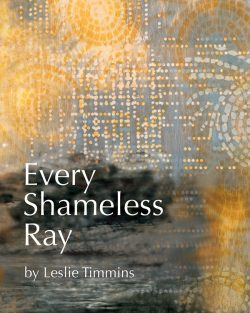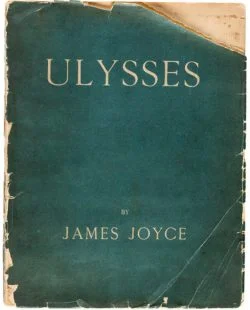#725 Tenebrous and illuminating
Every Shameless Ray
by Leslie Timmins
Toronto: Inanna Publications, 2018
$18.95 / 9781771335775
Reviewed by P.W. Bridgman
*
 As can be gathered from its enigmatic title, Vancouver poet Leslie Timmins’ first collection, Every Shameless Ray, is much concerned with matters of darkness, shadows and light. Oftentimes these conceits are introduced metaphorically in her poetry; at others they are presented simply in literal ways, allowing the poems fully executed (as opposed to discrete elements within them) to do the metaphorical heavy lifting.
As can be gathered from its enigmatic title, Vancouver poet Leslie Timmins’ first collection, Every Shameless Ray, is much concerned with matters of darkness, shadows and light. Oftentimes these conceits are introduced metaphorically in her poetry; at others they are presented simply in literal ways, allowing the poems fully executed (as opposed to discrete elements within them) to do the metaphorical heavy lifting.
There is much nuance in notions of darkness, shadows and light which may be explored by poets and applied to human situations. Many have traversed this ground before Timmins, and to pleasing effect — not just in poetry but in prose and music as well. Little wonder then that the poems comprising this collection call to mind, inter alia, Joni Mitchell’s musically and lyrically beautiful song, “Shadows and Light:”
Every picture has its shadows
And some source of light
Blindness blindness and sight
The perils of benefactors
The blessings of parasites
Blindness blindness and sight
Threatened by all things
Devil of cruelty
Drawn to all things
Devil of delight
Mythical devil of the ever-present laws
Governing blindness blindness and sight…

Like Mitchell’s, Timmins’ use of lightness and darkness imagery is agile and multivalent. While predominantly a positive force, revealing light is sometimes trained unsettlingly in these poems upon phenomena that, perhaps, might best be left in darkness. (In this way, that revealing light can be “shameless” in the sense apparently meant in the book’s title.) But similarly, while one finds many instances in the poems where references to darkness conjure dread and foreboding, elsewhere Timmins’ recourse to shadows brings to the mind’s eye a restful kind of comfort. This ability to manoeuvre between conflicting significations for the imagery she chooses in her work attests to the depth and breadth of her poetic gifts.
Timmins’ poem entitled “In the Morning When They Fling the Shutters Wide” exuberantly and simultaneously celebrates notions of darkness and light alongside evocations of rich and vibrant colour. In it we find Henri Matisse’s wife and daughter coming upon some paintings of the great master that they consider beneath his talent:

the cobalt sky, the roofs’ green rapture rushes
the unshielded room.
Canvasses lean like corpses against the wall,
their bruised fruit stain rags below.
Their silvery leaves. Pleasing. Mere vapours now.
Amélie Matisse and nine-year-old Marguerite
had agreed: he hadn’t got to joy…
They thereupon take matters into their own hands. Shockingly:
That night,
all night,
they washed and scraped until
all that remained
was canvas white.
Plainly, for Timmins (as for the females in the Matisse household), seeking to replicate in visual art, and in words, the riotous beauty of the natural and man-made worlds, with all their vivid colour and chiaroscuro, is a serious and occasionally fraught undertaking.
It should also be said that this poet takes great pleasure and delight in the wonders of the primarily visual world other than those sourced in the effects of light. Her highly developed powers of evocative description are well displayed in, for example, the following portrayal of killer whales breaching successively in Trincomali Channel (between Salt Spring and Galiano Islands):
A glossy black ridge carves up —
glimpse of white eye-patch, dorsal arc —
and then another whale glides into the side stream
of the first, then another mother, brother, calf,
fins and tail-flukes making archways in the bodies
of their kin and descend in sequence
as a visible music. (from “Dear Cancer, Part 14”)
This reviewer has seldom before seen Nature-as-master-choreographer so lyrically and convincingly captured in a poet’s words.

The longest poem in Every Shameless Ray is an epistolary one — entitled “Dear Cancer” — that deals with the subject of a worrisome diagnosis. It closely follows the contours of hope and despair that greet such a disquieting life event. The poem’s 22 parts are dotted here and there with arresting turns of phrase. At times the body is experienced, Timmins tells us, as a “sorrowing weight”. Ever vigilant for news, good or bad (i.e., light or dark) about the progress of her condition and its treatment, the patient “watch[es] the wind for another // prophecy.” Further, the reader is sometimes made privy to moments of self-doubt experienced by the patient—self-doubt that is nevertheless alloyed with hope regarding the objective seriousness of what her medical team has detected:
…have I betrayed myself?
one iffy blood-test and I make
my bed in the ragged earth
mainlining fear woozy
evidence of nothing much?
But during some nights:
…I climb in and out of graves
carry a limp Scottie dog and shake hands with the dead who,
it has to be said, look a lot like me…

“Dear Cancer” offers a discomfiting, but powerfully affecting and essential, window on the almost unimaginably dark ruminations that are set in motion when circumstance forces one to confront one’s own mortality. As Timmins succinctly (and ruefully) expresses it, there are “so many ways to die this side of the grave.”
Mention has already been made in this review of the appearance of Henri Matisse in Timmins’ poems. Indeed, Every Shameless Ray contains several ekphrastic poems occasioned by particular Matisse paintings which have caught the poet’s imagination. These paintings, as one might expect, summon from Timmins some of the most richly descriptive passages in her book. Again, light-to-dark and red-to-violet chromatic and prismatic continua — with all of their infinite gradations — feature prominently. Their impact is, in turn, greatly amplified by the deft use of run-on lines heavily freighted with adjectives and adverbs, giving the writing a dizzying, sometimes upending, quality. We see this in the prose poem, “From That Night a Fine Disorder:”
…forty-foot square and scarlet, a great red bird soaring through a blue room and Matisse finally letting the winged line rule, enter where it wished, die where it would, transfusing the whole blue room blood red, the table at its centre a moving read feast, its far edge lash-thin, its near no edge at all so its patterned cloth floats, floods up the wall in arabesque arcs…

This kind of vertiginous phrasing owes something, perhaps, to passages like the one quoted below from Ulysses where Joyce describes a bounteous table laden with foodstuffs in an appealingly woozy and runaway-train-like manner:
…Thither the extremely large wains bring foison of the fields, flaskets of cauliflowers, floats of spinach, pineapple chunks, Rangoon beans, strikes of tomatoes, drums of figs, drills of Swedes, spherical potatoes and tallies of iridescent kale, York and Savoy, and trays of onions, pearls of the earth, and punnets of mushrooms and custard marrows and fat vetches and bere and rabe and red green yellow brown russet sweet big bitter ripe pomellated apples and chips of strawberries and sieves of gooseberries, pulpy and pelurious, and strawberries fit for princes and raspberries from their canes.
To conclude, then, Leslie Timmins has given us, in Every Shameless Ray, a challenging collection of powerful and evocative poems — poems which are at once tenebrous and illuminating, and which will test the elasticity of her readers’ minds and imaginations. Her use of language is adventurous and her choice of subject matter is relevant, resonant and (at times) other-worldly. Timmins is a poet’s poet, to be sure; that said, she also deserves a readership that lies outside the ramparts of that particular castle. It is to be hoped, if not expected, that Every Shameless Ray will ensure that she gets it.
*

P.W. Bridgman writes from Vancouver. In 2018 he studied with, among others, Ciaran Carson, Doireann Ní Ghríofa, Leontia Flynn, Gerald Dawe, Edna Longley and Stephen Sexton at the intensive writing summer school program offered by the Seamus Heaney Centre for Poetry at Queen’s University, Belfast—an experience that he says was a transformative one in his writing life. Bridgman’s selection of poems, entitled A Lamb, was published by Ekstasis Editions in late 2018. (Editor’s note: A Lamb was reviewed by David Stouck in The Ormsby Review, no. 505, April 2, 2019). It was preceded by a selection of short fiction entitled Standing at an Angle to My Age, published by Libros Libertad in 2013. Bridgman’s writing has appeared in Grain, The Antigonish Review, The Moth Magazine, The High Window, The Glasgow Review of Books, The Honest Ulsterman, The Bangor Literary Journal, The Galway Review, Ars Medica, Poetry Salzburg Review and other periodicals and anthologies. Learn more at www.pwbridgman.ca.
*
The Ormsby Review. More Books. More Reviews. More Often.
Publisher and Editor: Richard Mackie
The Ormsby Review is a journal service for serious coverage of B.C. books and authors, hosted by Simon Fraser University. The Advisory Board consists of Jean Barman, Robin Fisher, Cole Harris, Wade Davis, Hugh Johnston, Patricia Roy, David Stouck, and Graeme Wynn. Scholarly Patron: SFU Graduate Liberal Studies. Honorary Patron: Yosef Wosk. Provincial Government Patron since September 2018: Creative BC
“Only connect.” – E.M. Forster